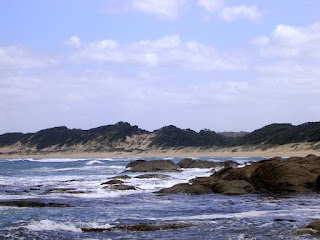The road from Paynesville to Eden is about 220 kms. And we have to admit that it was rather boring. Although the road—Princes Highway--runs parallel to the coast, we got only rare glimpses of the sea, and a large part of the trip was through what would be called ‘bush’ here. We would call it woodland. And the road was winding and rolling with some steep up-hills and down-hills. It was only two lanes, but there were stretches of passing lanes every few kilometers.
We did make an excursion off the main road to a headland called Cape Conran, where we took a few cliché pictures of sandbars, waves breaking on rocks—you know the sort of thing: when you don’t worry about wasting film, it is almost a reflex action to take these pictures. You can skip them.
But there were some oddities. These bright purple berries, for example.
And these strange rock formations.
We stopped and had our lunch--sandwiches (made by Joan the night before) in a small park in a place (hardly a town) called Cann River, and it occurred to me how typical the little park was: we have seen dozens and dozens like it. The childrens’ playground was shaded by the obligatory canvas canopies to keep the sun off the kids.
There were the shelters with one or more picnic tables. This one only had one. And under the shelter—the electric barbeque.
No charge: use the electricity to do your grilling. This shelter only had one, but we have seen shelters with two and more. The Australians love to picnic: and when they picnic, they love to barbeque. We have seen large family groups crowded under these shelters with two barbeques in operation. Possibly the provision of electric barbeques is to discourage the use of charcoal fires--given the usual concern about bush fires.
And this was a refinement we had not seen before--somewhere to do the dishes.
On into Eden and our beach-side cottage for the next two nights. As we turned off the highway, there was the sound of –what?—wind-chimes, bells? Was it the damn car? We stopped, but the chiming went on. Must be wind-chimes somewhere. But when we asked the motel manager what the bells were, he explained that it was the bell-bird that made them. They continue to chime away as I sit at the computer. Go into You Tube, and you can hear them: search bell bird.
Eden was the centre of a thriving off-shore whaling industry, with the boats crewed mainly by aboriginals. Now it aims to attract the tourists with whale watching—subject to strict rules as to how close to the whales you are allowed to get. The whales migrate up from the Antarctic in the spring and there are none in evidence at this time of the year.
Eden has some rocky headlands and one long surf beach.
It also seems to have strange liquor laws. I was told in the supermarket that the only place I could buy beer was at the Fishermen’s Club, where I had to sign in as a temporary member before I could buy a six-pack of beer. To get to the Club, I managed inadvertently to drive the wrong way down a one-way street. Joan was displeased, at least until I returned with the beer.





















































